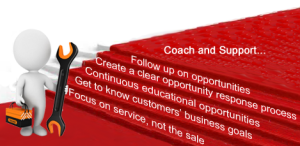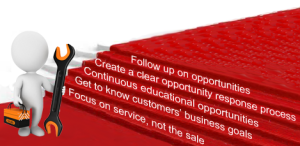 I tried to make an appointment last Monday to take my motorcycle in for the end of season oil change and instead I learned the 6 steps on how to use the telephone to turn away business. I thought it might be helpful to share it with you.
I tried to make an appointment last Monday to take my motorcycle in for the end of season oil change and instead I learned the 6 steps on how to use the telephone to turn away business. I thought it might be helpful to share it with you.
Step 1: Put callers on hold for long periods. I realize that this is not a new revelation, but I am amazed that, with the technology available today, some companies are able to persist in putting people on indefinite hold. All it took for me was to ask for the “service department”. After what seemed like several minutes, the receptionist returned to the line and said, “I can’t seem to find him anywhere! Would you like to leave a voicemail?” Which brings me to Step 2 of using the telephone to turn away business.
Step 2: Don’t be available – especially if you are in the “service” department. I have no idea where the service manager/advisor was (and apparently I was not the only one), but not having anyone who can handle a service call in the middle of the day is one sure way to let the customer know that you do not believe they are important.
Step 3: Don’t return your calls. No matter what, don’t call the customer back – certainly not on the same day! Prompt responses to voicemail messages only serves to encourage more customers to leave more messages that might result in more business.
Step 4: Make sure you are able to set your phone system so that callers cannot reach a live person during busy periods. This is especially important to screen out angry callers who want to know why you haven’t responded to their voicemail. This particular system would not let you dial “zero” to reach a live person. You could only dial “1” for service, “2” for sales, “3” for … (Refer to Step 2).
Step 5: Encourage your staff to talk negatively about the company. This is a particularly good one and highly recommended if you are serious about reducing the number of pesky customers. In my case, after several attempt at reaching the “service” department (Press “1”), I decided to try to reach a salesperson (Press 2). It worked! A rather unenthusiastic voice announced “Sales” and asked how he could help. I explained to him that I was trying to reach the service department and was unable to get any response. I asked if he could see anyone. “Hang on” he replied and put me on hold. (See Step 1), “I found him, but he is on the phone,” came the eventual reply (See Step 2). I told him that I thought his phone system was terrible. “Yes!” he agreed. “It’s not been the same since we got the new system last year. We keep telling the boss that it sucks but he won’t listen.” This was the first bit of enthusiasm I could detect in his voice. He obviously took Step 5 seriously.
Step 6: Tell people how busy you are. This assumes that you failed at Step 2 and the persistent caller finally manages to break through your defenses. I finally got through to the service advisor/manager at about 4:55 that evening – I had been trying since 9:00 am. I explained who I was and that I had left a voicemail message early that morning. “Oh yeah! I got your message and you’re 23 on my list to call back. What do you need?” (“What do you need?” is industry jargon for “How may I help you?”). I repeated the information that I left on the original voicemail – that I would like an oil change and hoped to be able to schedule it for Thursday morning and that I would like to wait. “What time do you have available?” I inquired. “What time do you want to bring it in?” he responded. “Early, if possible.” I replied. “Well, we’re wide open so name the time.” Wide open? How could they be so quiet and yet be so busy?
And then it hit me. Their strategy was working! Use the telephone to turn away business and get rid of those pesky customers who only end up making the job more complicated. I started to wonder if service manager/advisor and everyone else were really busy at all, or were they just pretending they were as part of the strategy (Step 6).
Now, I should explain that the manufacturer of the motorcycle I ride has only one authorized service centre in my area so, unless I am prepared to ride a considerable distance, I don’t have much choice on where I take my bike for service. Given the experience I just had, I don’t imagine that this will be a problem for very long.
How about your organization? Are you turning away business too?
I’d love your feedback! And as always, please feel free to leave a link back to your own blog if you have one via the commentluv feature here on the site. If you are reading this blog post via email, you will need to locate this post on my website by clicking here. Scroll down to the bottom of the page where you will find the comment section.
Jim
“A customer is the most important visitor on our premises, he is not dependent on us. We are dependent on him. He is not an interruption in our work. He is the purpose of it. He is not an outsider in our business. He is part of it. We are not doing him a favor by serving him. He is doing us a favor by giving us an opportunity to do so.”?
– Mahatma Ghandhi
 It was a rude awakening to a valuable reminder. Bang! I was in Calgary to present a seminar on communicating value. I squinted at the hotel alarm clock. Not quite five. Bang! There it was again. Another insensitive guest on their way to an early start I surmised and closed my eyes.
It was a rude awakening to a valuable reminder. Bang! I was in Calgary to present a seminar on communicating value. I squinted at the hotel alarm clock. Not quite five. Bang! There it was again. Another insensitive guest on their way to an early start I surmised and closed my eyes.
 I tried to make an appointment last Monday to take my motorcycle in for the end of season oil change and instead I learned the 6 steps on how to use the telephone to turn away business. I thought it might be helpful to share it with you.
I tried to make an appointment last Monday to take my motorcycle in for the end of season oil change and instead I learned the 6 steps on how to use the telephone to turn away business. I thought it might be helpful to share it with you. Recently, I had the opportunity to observe a manager of a large, electronics store deal with emotional customers to a positive result. My daughter and I were the emotional customers.
Recently, I had the opportunity to observe a manager of a large, electronics store deal with emotional customers to a positive result. My daughter and I were the emotional customers. At one of our Proactive Service® workshops, one of the techs – let’s call him John – told me, “They don’t pay me to look good, they pay me to fix things!”. We were discussing the importance of how we personally present ourselves at the customer’s facilities. John, who looked like he hadn’t shaved in a few days and was wearing a well-worn company T shirt, was obviously not convinced about the importance of appearance in service delivery. It wasn’t the first time I had heard this.
At one of our Proactive Service® workshops, one of the techs – let’s call him John – told me, “They don’t pay me to look good, they pay me to fix things!”. We were discussing the importance of how we personally present ourselves at the customer’s facilities. John, who looked like he hadn’t shaved in a few days and was wearing a well-worn company T shirt, was obviously not convinced about the importance of appearance in service delivery. It wasn’t the first time I had heard this. We’ve all experienced it. You need to get something done and the customer service person you are relying on says, “I can’t help”. The solution requires a little bit of empathy, perhaps some creativity and a lot of common sense. Although the clerk may be smart, efficient and good at their job, they fail to show any of the three requirements. There is no empathy, little creatively and certainly no evidence of common sense.
We’ve all experienced it. You need to get something done and the customer service person you are relying on says, “I can’t help”. The solution requires a little bit of empathy, perhaps some creativity and a lot of common sense. Although the clerk may be smart, efficient and good at their job, they fail to show any of the three requirements. There is no empathy, little creatively and certainly no evidence of common sense. In step 5 of
In step 5 of  The 5th step in creating a Proactive Service® culture within your service team is to follow-up on opportunities. Following up on opportunities may seem like a self-evident step, but it is often not accomplished.
The 5th step in creating a Proactive Service® culture within your service team is to follow-up on opportunities. Following up on opportunities may seem like a self-evident step, but it is often not accomplished. The fourth step in creating a Proactive Service® culture for your field service team is to ensure that there is a clear and consistent process for handling opportunities from the field. Without a clear process, we leave the follow-up largely to chance and create the potential for frustration and resentment on the part of our technicians and customers.
The fourth step in creating a Proactive Service® culture for your field service team is to ensure that there is a clear and consistent process for handling opportunities from the field. Without a clear process, we leave the follow-up largely to chance and create the potential for frustration and resentment on the part of our technicians and customers. In the
In the  In the
In the 

